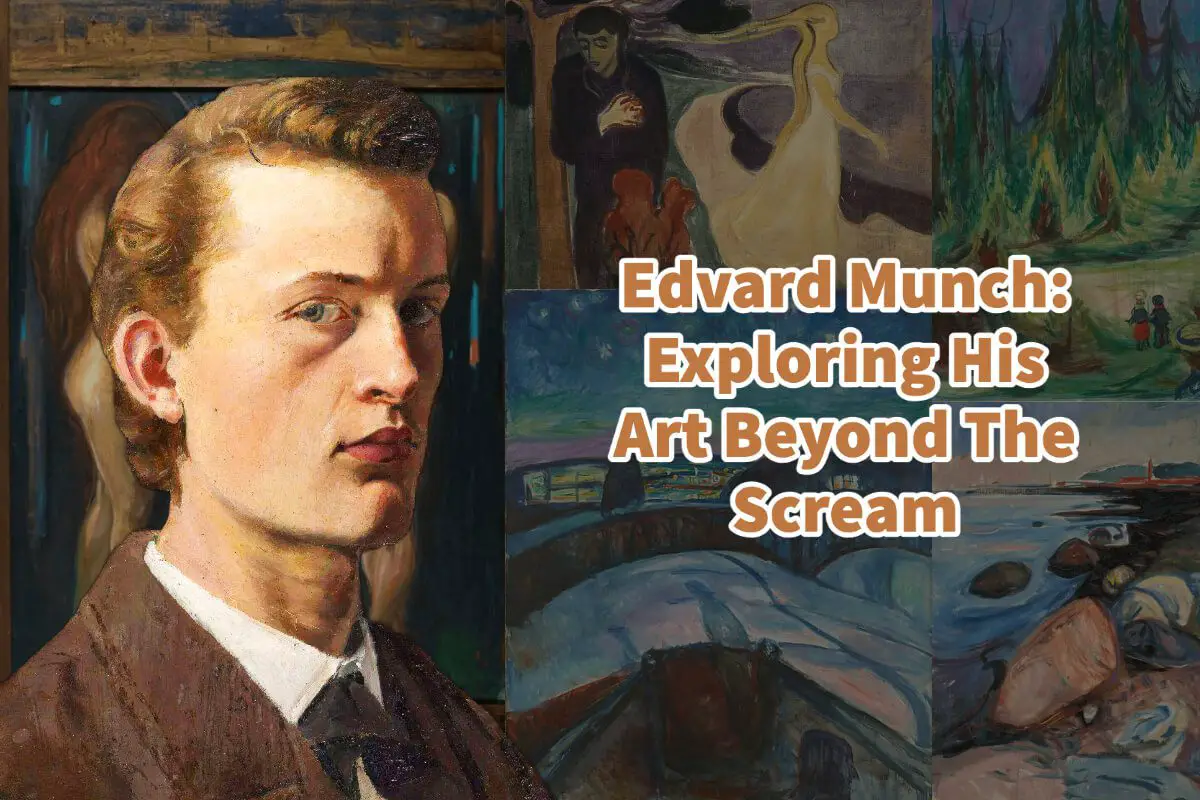One of my favorite artists is the Norwegian artist Edvard Munch. His painting The Scream continues to be an iconic work of art.
Even though Edvard Munch, the renowned Norwegian artist, is often associated with his iconic painting “The Scream.” However, his artistic journey and contributions extend far beyond this single work. Munch’s early life experiences profoundly influenced his perception of the world, and his unique artistic style emerged. Read on as we explore Munch’s formative years and delve into the diverse range of his paintings that showcase his extraordinary talent and creativity.
Table of Contents
- About The Norwegian Painter – Edvard Munch
- Edvard MunchWas More Than The Painter Of The Scream
- 10 Of Edvard Munch’s Most Important Works Of Art
- “The Sun” (1912) by Edvard Munch
- “The Scream” (1893) and “The Scream Lithograph” (1895) by Edvard Munch
- “Beach” (1904) by Edvard Munch
- “The Girls On The Bridge” (1902) by Edvard Munch
- “Starry Night” (1922-1924) by Edvard Munch
- “Self Portrait with Palette” (1926) by Edvard Munch
- “Metabolism (Life and Death)” (1896) by Edvard Munch
- “Separation” (1896) by Edvard Munch
- “The Fairytale Forest” (1927-1929) by Edvard Munch
- “Fertility” (1899-1900) by Edvard Munch
- Edvard Munch Has A Wide Range of Art Works
- Related Questions
About The Norwegian Painter – Edvard Munch

Edvard Munch is commonly recognized for his iconic painting “The Scream.” But the renowned Norwegian artist’s artistic journey and contributions extend well beyond this singular masterpiece.
Munch’s formative life experiences left an indelible mark on his perception of the world, ultimately giving rise to his distinctive artistic style.
Edvard Munch’s Dark Early Years
Dark bedrooms were a constant in Munch’s youth. He was the sickly second child of five children; he was born on December 12, 1863, in Loten, Norway.
Chronic asthmatic bronchitis and rheumatic fever plagued him, forcing him to spend entire winters indoors. Munch’s mother, Laura, came from a family ravaged by tuberculosis, a disease that cast a dark shadow over their lives.
Edvard Munch’s Mother Passes Away
Unfortunately, Laura his mother passed away when Edvard was just five years old. Following her death, Laura’s sister Karen took charge of the household and recognized Edvard’s artistic potential. She encouraged him to draw and meticulously preserved his work, setting the stage for his future as an artist.
At Age 17, Edvard Munch Made Decision To Be An Artist
At the age of 17, Munch made a firm decision to pursue art as a career. His resolve was fueled by the tragic loss of his beloved elder sister, Sophie, to tuberculosis in 1877.
Sophie’s death had a profound impact on Munch, altering the trajectory of his life. The experience deepened his sensitivity to mortality and left an indelible mark on his artistic vision.
Edvard Munch Had A Whirlwind Artistic Period In1890s
The 1890s marked a whirlwind period for Munch, filled with artistic success, scandal, and personal setbacks. Amid disastrous romances, excessive drinking, gambling, and battles with depression, Munch’s father passed away.
Munch spent much of this decade traveling between Paris, Berlin, and Nice, where he mingled with prominent writers and poets of the time, such as August Strindberg, Henrik Ibsen, Stéphane Mallarmé, and Stanislaw Przybyszewski, a Polish poet, and self-declared Satanist.
Edvard MunchWas More Than The Painter Of The Scream
It is important to note that Munch was more than just the painter of “The Scream.” His body of work encompasses various subjects, styles, and techniques.
Although he was not an impressionist, Munch frequently painted outdoors, particularly in a large, open-roof studio on his property in Norway. His intuitive approach and rapid brushwork sometimes make his paintings flimsy, evoking a certain carefree, proto-hippie vibe reminiscent of summer painting from Maine.
Munch Could Infuse Structure And Depth Into Work
However, Munch’s ability to infuse structure and depth into his work distinguishes him as a superb draftsman with a powerful sense of design and composition. He dramatized his encounters with nature by emphasizing specific pictorial tensions.
For instance, he often juxtaposed looming foreground figures against deep-rushing diagonals. Furthermore, he employed gracefully curling Art Nouveau outlines to enhance the impact of his thin paint and loose brushwork.
Munch’s mastery of color is also evident, as he skillfully utilized strident hues with dull and indeterminate tones. His art is alive with bosky greens and palpitating mauves, intensifying the impact of localized red and yellow accents.
Munch subscribed to Émile Zola’s belief that art is “a corner of nature seen through a temperament.” However, he added his twist by substituting “mood” for “temperament,” emphasizing the transient nature of moods.
Munch Believed Artist Must Capture The Essences Of The Moment
Munch believed you could not simply observe and accurately paint your surroundings as an artist. Instead, capturing the moment’s essence when the subject matter is seized would be best.
This concept of artistic seizing was integral to Munch’s creative process. He always emerged from his dark, ink-filled bedrooms with a greedy, wide-eyed perspective, eagerly embracing what he saw.
Munch’s ability to translate his sensory experiences into his artwork is particularly striking in his depictions of natural elements. His paintings of trees, shorelines, rocks, and moons possess a startling sensibility.
They seem to pulsate with life, as if invisible arms extend from the canvas, beckoning the viewer to engage with the scene. Munch’s connection to nature is palpable, and he masterfully captures the dynamic energy and ever-changing beauty of the natural world.
10 Of Edvard Munch’s Most Important Works Of Art
While it is impossible to discuss all of Edvard Munch’s significant works of art, it is essential to acknowledge some of his unique pieces. Let’s explore a selection of paintings and lithographs that exemplify Munch’s artistic prowess:
“The Sun” (1912) by Edvard Munch
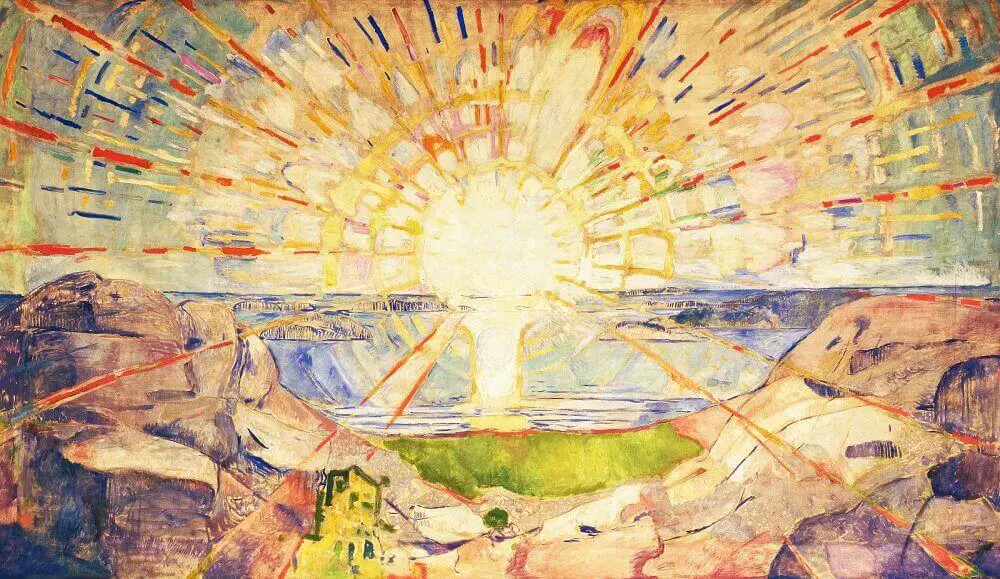
This painting showcases Munch’s skillful use of color and composition. It depicts a vibrant, sunlit landscape with bold brushwork and striking contrasts, capturing the radiance and warmth of the sun.
“The Scream” (1893) and “The Scream Lithograph” (1895) by Edvard Munch
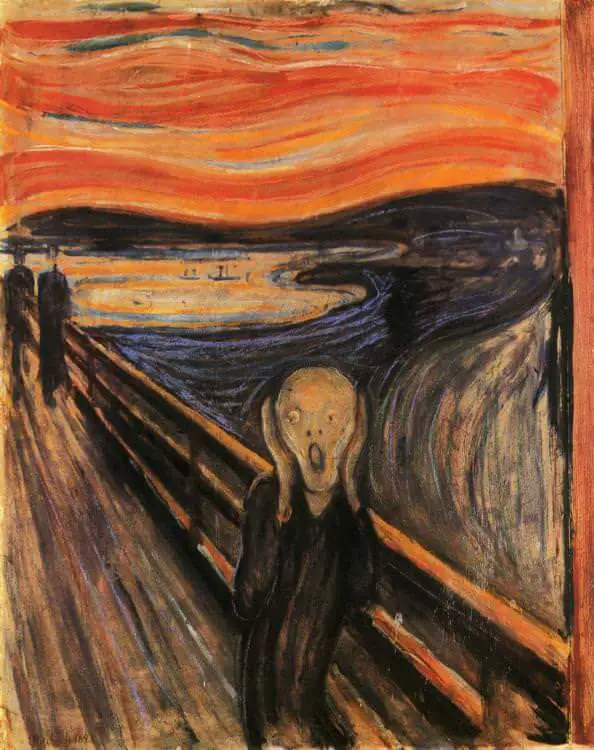
These iconic works epitomize Munch’s ability to convey intense emotions and existential angst. The swirling colors and distorted figures in “The Scream” evoke a sense of terror and existential dread, making it one of the most recognizable and influential artworks ever.

“Beach” (1904) by Edvard Munch

Munch combines his affinity for nature with his introspective style in this painting. The tranquil beach scene is infused with melancholy and contemplation, inviting viewers to reflect on the fleeting nature of existence.
“The Girls On The Bridge” (1902) by Edvard Munch
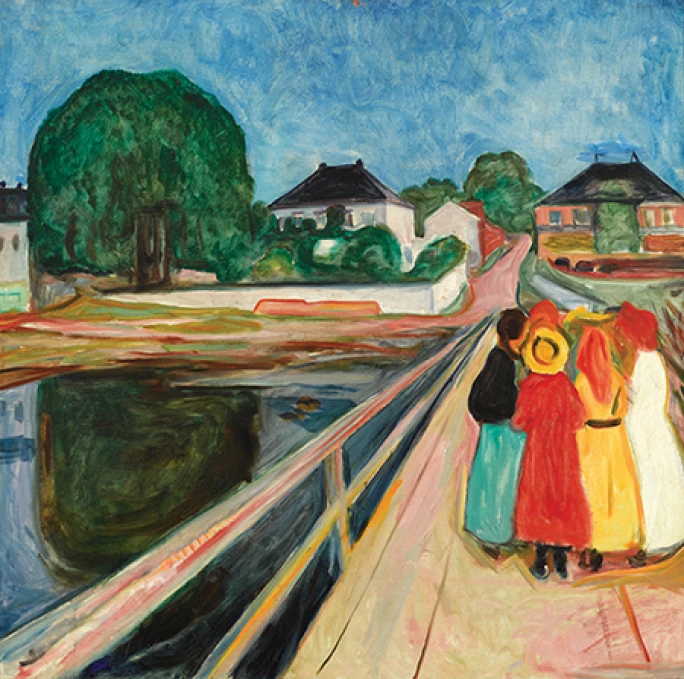
This stunning canvas showcases Munch’s genius with its vibrant colors, strong perspective, flowing lines, and deep existential emotions. Munch’s impact on 20th-century art cannot be overstated. His influence can be seen in Expressionism, Fauvism, and Pop art.
“Starry Night” (1922-1924) by Edvard Munch
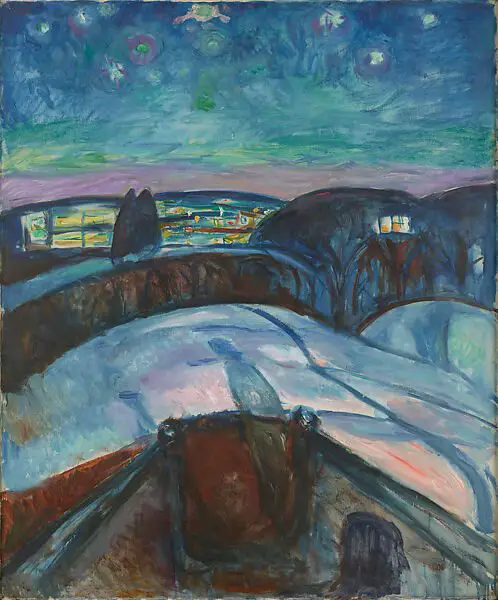
We do not know if the works of Vincent van Gogh inspired this, but we know that Munch created his interpretation of the starry night sky. The painting exudes a mystical quality, with swirling patterns and vibrant colors, capturing the ethereal beauty of the night.
“Self Portrait with Palette” (1926) by Edvard Munch
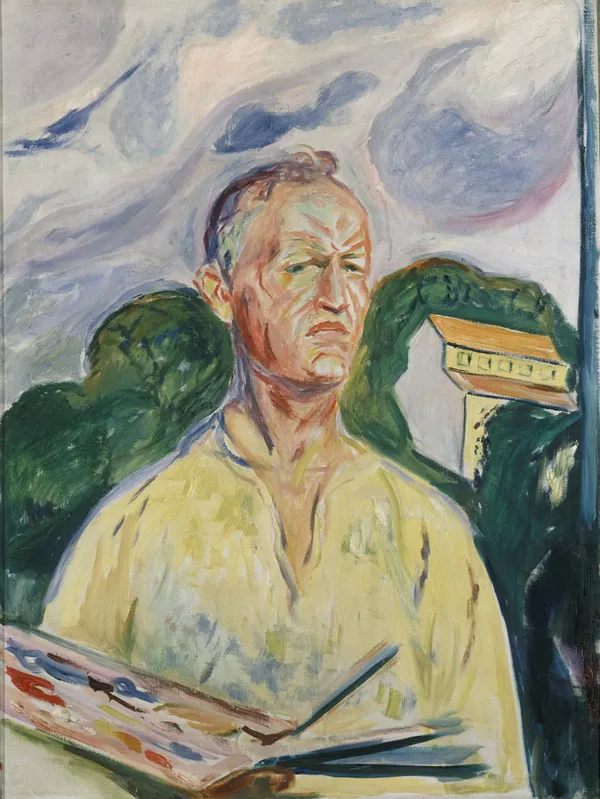
This self-portrait reveals Munch’s reflective nature. The somber expression and penetrating gaze convey a profound self-awareness and contemplation.
“Metabolism (Life and Death)” (1896) by Edvard Munch

Munch delves into the themes of life and death in this captivating art.›››. The contrasting elements of growth and decay create a dynamic tension, symbolizing the fragile balance between existence and mortality.
“Separation” (1896) by Edvard Munch

This emotionally charged piece portrays the anguish and heartache of a fractured relationship. Munch’s use of color and expressive brushwork captures the raw intensity of human emotions.
“The Fairytale Forest” (1927-1929) by Edvard Munch
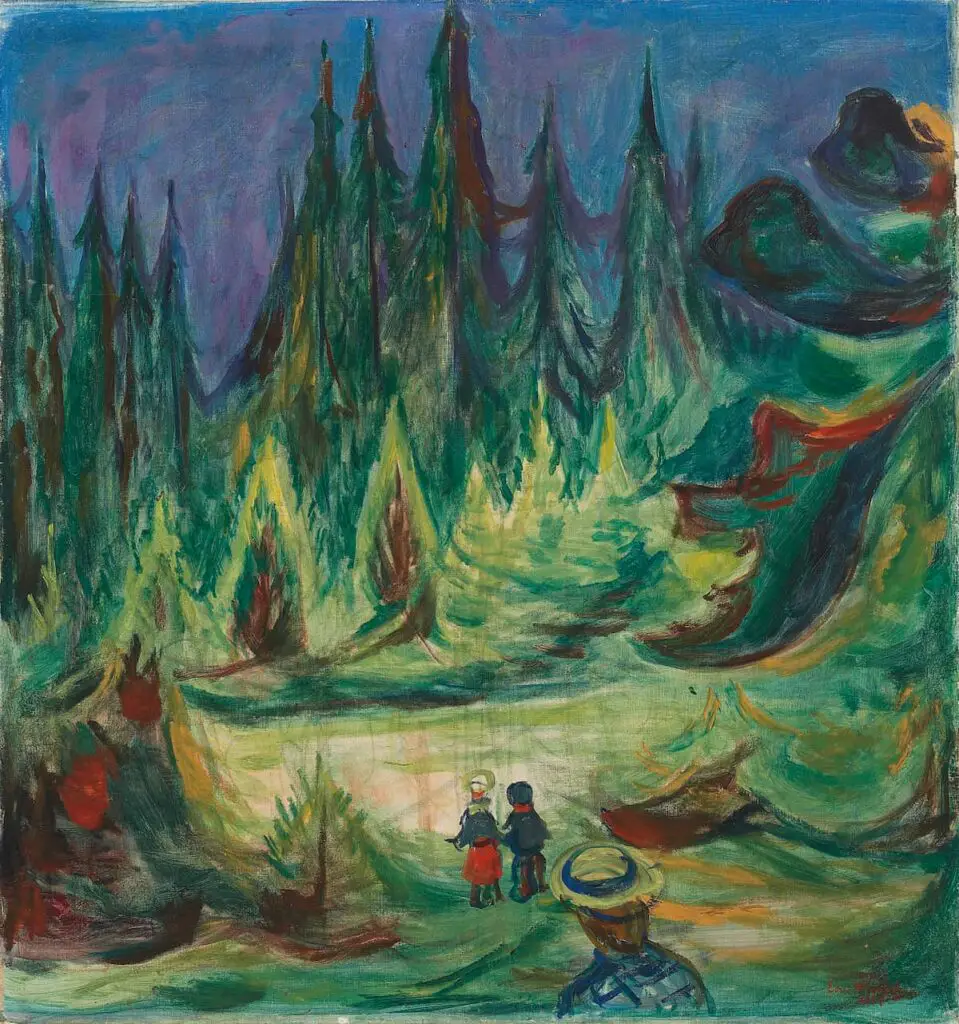
In this beautiful painting, Munch combines elements of fantasy and nature, blurring the boundaries between reality and imagination. The vibrant colors and intricate details create a captivating and otherworldly atmosphere.
“Fertility” (1899-1900) by Edvard Munch
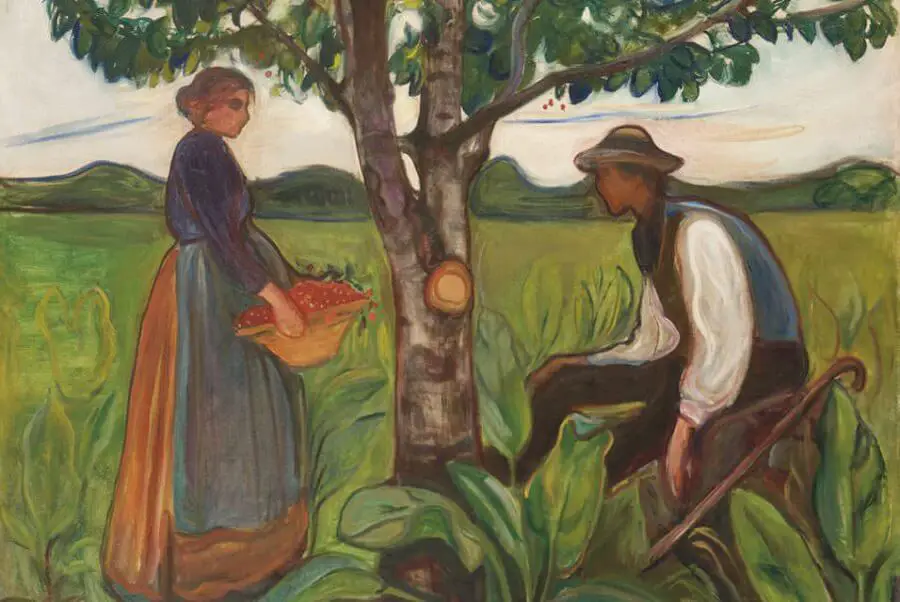
This symbolic painting explores themes of sexuality and rebirth. Munch’s use of flowing lines and organic forms evokes a sense of sensuality and vitality, reflecting his fascination with the complexities of human relationships.
Edvard Munch Has A Wide Range of Art Works
Edvard Munch’s work spans various subjects, styles, and themes. While “The Scream” remains his most recognizable work, it is essential to recognize the depth and breadth of his artistic contributions.
Munch’s art goes far beyond a single painting, encompassing many emotions, experiences, and interpretations of the human condition.
His exploration of the inner psyche and the existential angst that permeates his work resonates with viewers profoundly. Munch’s ability to distill complex emotions into visual representations is a testament to his artistic genius and deep understanding of the human experience.
In addition to his paintings, Munch excelled in the medium of lithography. Lithographs such as “The Scream Lithograph” showcase his mastery of capturing mood and atmosphere through line and texture.

These works allowed Munch to reach a wider audience and further solidify his reputation as a groundbreaking artist.
Munch’s impact on the art world extends far beyond his own time. His innovative approach to composition, use of color, and exploration of the inner self laid the groundwork for subsequent artistic movements, including Expressionism and Symbolism.
His influence can be seen in the works of artists such as Egon Schiele, Oskar Kokoschka, and even later artists like Jackson Pollock.
Listen To Our Podcast About The Life Of Edvard Munch below or by clicking here.

Edvard Munch Has A Legacy As An Important Art Figure
Edvard Munch’s legacy as one of the most influential figures in art history is indisputable. His ability to capture the raw emotions of the human experience, his introspective nature, and his unique artistic vision set him apart as a true pioneer.
As we delve into the world of Edvard Munch, we discover an artist whose early life experiences profoundly influenced his artistic vision.
Munch’s ability to convey his innermost thoughts and emotions through his artwork is a testament to his extraordinary talent and creativity. His paintings offer a glimpse into the human psyche, exploring themes of love, death, anxiety, and desire.
Through his innovative use of color, composition, and expressive brushwork, Munch created a visual language that resonates with viewers today.
Edvard Munch’s early life experiences and struggles greatly influenced his artistic vision. From his dark and isolated childhood to his encounters with illness, loss, and existential questions, Munch’s art emerged as a reflection of his inner world.
Anita Louise Art is dedicated to art education, great artists, and inspiring others to find and create their art. We love art that uplifts and inspires. #ArtToMakeYouSmile! #ArtToMakeYouHappy!
If you want to see any of my art, you can find out more by clicking here. If you are interested in what inspires me and my paintings, you can discover more by clicking here.
We have a free newsletter and would love you to be part of our community; you can subscribe to the newsletter by clicking here. If you have any questions, I would be happy to talk to you. You can reach me, Anita, by clicking here.
Subscribe to our Anita Louise Art YouTube Channel, filled with great videos and information by clicking here.
Join us for our podcast “5 Minutes With Art.” Spend 5 minutes a week with us to discover and learn about great art and artists. You can find out more about our podcast by clicking here.
Related Questions
When Did The Renaissance Start? Exploring The Cultural Rebirth
The Renaissance, a period of remarkable cultural, artistic, and intellectual growth, is often hailed as one of the most transformative eras in history. While its starting point is a subject of debate among scholars, most scholars feel the Renaissance started in the 14th Century in Italy. Then after that time, the Renaissance gradually unfolded across Europe, leaving a lasting impact on society.
By clicking here, you can learn more by reading When Did The Renaissance Start? Exploring The Cultural Rebirth.
Fine Art: Definition, Meaning, And Its Importance
Fine art encompasses many forms, including painting, sculpture, printmaking, photography, and architecture. Read on as we will explore the definition and meaning of fine art, examine its historical significance, and discuss the ten compelling reasons why understanding fine art is essential for artists and art enthusiasts alike.
By clicking here, you can learn more by reading Fine Art: Definition, Meaning, And Its Importance.
15 Most Famous Abstract Art And Why They Are Famous
There are many great abstract works of art, so choosing my favorite 15 works can be challenging. But we have chosen 15 of our favorite works of art and why we consider them to be not only famous but also why they are essential. Read on as we will explore 15 of the most famous abstract artworks, delving into the artists’ names, the years of creation, and the reasons behind their enduring fame.
By clicking here, you can learn more by reading 15 Most Famous Abstract Art And Why They Are Famous.

